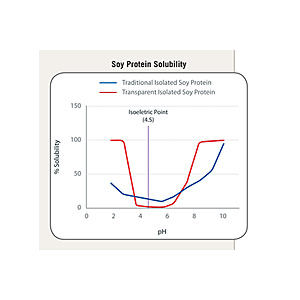Processing low pH protein-fortified beverages
Comparing traditional soy with new transparent soy protein

|
Soy protein-fortified beverages usually are formulated with traditional isolated soy protein varying in functionality and sensory attributes. Recently, a new transparent acid-soluble isolated soy protein (TASISP) has been developed through alternative processing methods. Traditional soy proteins typically are spray dried at a pH above the isoelectric point. As a result, these proteins create an opaque appearance when incorporated into a beverage. The new TASISP is spray dried at a pH below the isoelectric point. This TASISP has high solubility in the acidic pH range below 4.0.
Proper formulation and processing of low pH ready-to-drink (RTD) and powdered soy beverages are keys to ensuring stability and consumer appeal. Key processing advantages exist with TASISP compared to traditional soy protein in beverages with a final pH below the isoelectric point. Isoelectric point is defined as the pH at which the total charge on the protein molecule is equivalent to zero, resulting in the neutralization of available amino and carboxyl groups, according to S.A. Iqbal and Y. Mido, the authors of the 2005 book “Food Chemistry.” At this pH, the protein is not soluble, and as a result the protein precipitates out of solution.
The isoelectric point of soy protein has a pH around 4.5. Traditional isolated soy protein is most soluble above the isoelectric point. At pH values below 4.0, the new TASISP is 100 percent soluble making it an ideal protein ingredient for sports drinks, fruit juice blends, powdered mixes, fortified waters and fruit-flavored beverages (see figure at right).
Proper formulation and processing of RTD and powdered soy beverages with a final pH near the soy protein isoelectric point are keys to ensuring stability and consumer appeal. Key processing advantages exist with TASISPs over traditional soy proteins in both beverage categories.
For RTD beverages, traditional isolated soy proteins require moderate to high shear mixing in 120-degrees Fahrenheit tempered water for a minimum of 10 to 15 minutes to ensure proper hydration. Fruit-based soy beverages are formulated in a pH range below 4.2 resulting in distinct flavor and texture characteristics distinguishing these beverages from their neutral soy beverage counterparts and providing consumers with refreshing and tasty alternatives.
Due to the solubility of traditional soy protein in water, acidification is required to lower the pH of beverage solutions through the isoelectric point of soy protein to achieve the desired final pH of the beverage. The low solubility of traditional isolated soy protein below the isoelectric point requires incorporation of stabilizers designed for low pH beverages as well as homogenization for maximum stabilization. The product is subsequently pasteurized using either high-temperature short-time (HTST) or ultra high temperature (UHT) conditions.
In comparison, the new TASISP does not require tempered water for hydration, addition of stabilizers or homogenization for stabilization due to high solubility at pH values below 4.0. Medium to high shear is required to properly hydrate the TASISP in water, followed by the addition of other ingredients and HTST or UHT pasteurization.
The key difference between formulating low pH powdered beverages with traditional soy protein and TASISP is the use of hydrocolloids as stabilizers. When formulating low pH powdered beverages with traditional isolated soy protein, stabilizers are incorporated to prevent separation and to contribute to mouthfeel and viscosity. Due to higher solubility displayed by TASISP at low pH ranges, stabilizers are not required for stability or mouthfeel.
Key flavor attributes also distinguish traditional isolated soy protein from TASISP. Slight beany, cereal, bitter and/or astringent flavors may be associated with traditional isolated soy protein. The degree of these attributes varies between traditional isolated soy protein. TASISP is characterized as having an overall clean and bland flavor, with slight astringency. Efforts are currently under way to mask or modulate the astringency associated with TASISP.
Like other sectors of the protein-based food market, consumer demand for convenient foods that deliver protein, like protein beverages, will increase due to better awareness of healthy eating habits. Fortified soy protein beverages often are recognized by consumers as a source of high quality protein, having low saturated fat content and can be free of cholesterol.
In a market that experiences continued growth, ingredient diversification is a vital component to the success of that market. TASISPs have excellent functional properties for delivering protein in low pH beverages. The TASISP also can be added to beverage systems not typically fortified with soy protein, such as citrus-flavored drinks, fruit-flavored waters and sports recovery beverages. In addition to nutritional value, TASISP delivers transparency and high solubility in low pH beverage systems, key factors that will strengthen consumer acceptance in a well-established juice beverage market. BI
Looking for a reprint of this article?
From high-res PDFs to custom plaques, order your copy today!



